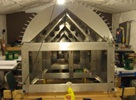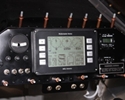


random user submitted photo
Cowling and Cooling
6 posts
• Page 1 of 1
Cowling and Cooling
Recently we were made aware of a builder who flew his airplane without the cowling installed. I thought it would be appropriate to post a reminder to the group that this is NOT a good idea. The cowling forms the top of the cooling plenum. This forms the high pressure area above the engine that forces air down through the cooling fins on the cylinders and heads. Air is a fluid, and like all fluids, it seeks the path of least resistance. If the cowling is not in place there is no plenum formed and nothing to force the air down through the cooling fins. Thus, the air will simply flow around the engine and not through the fins and you have no control over what, if any, cooling is taking place. Your CHT may or may not show a problem, but there's no way to know if there are hot spots in other areas of the cylinders or heads. The only way to make sure you are getting complete airflow through the cooling fins is to fly with the cowl in place.
Joe Norris
Sonex N208GD (S/N 450)
Sonerai II N13NN (S/N 1206)
Fortes Fortuna Adiuvat
Sonex N208GD (S/N 450)
Sonerai II N13NN (S/N 1206)
Fortes Fortuna Adiuvat
-

Sonerai13 - Posts: 411
- Joined: Tue Nov 05, 2013 5:36 pm
- Location: Oshkosh, WI
Re: Cowling and Cooling
Thanks for the reminder Joe. What about running without the cowling on the ground?
I recently made my first start tests and had the cowling off so others could watch for fuel/oil/smoke/flame and standby with a fire extinguisher. A friend of mine who is in A&P class said the teacher recently gave a lecture about this, saying that even on the ground, running without a cowling and baffles installed is very hard on the engine. He said for first start you should run for no more than 3 minutes without the cowling, check for leaks/issues, then always use the cowling going forward, ESPECIALLY on the ground.
I recently made my first start tests and had the cowling off so others could watch for fuel/oil/smoke/flame and standby with a fire extinguisher. A friend of mine who is in A&P class said the teacher recently gave a lecture about this, saying that even on the ground, running without a cowling and baffles installed is very hard on the engine. He said for first start you should run for no more than 3 minutes without the cowling, check for leaks/issues, then always use the cowling going forward, ESPECIALLY on the ground.
Ryan Roth
N197RR - Waiex #197 (Turbo Aerovee Taildragger)
Knoxville, TN (Hangar at KRKW)
My project blog: http://www.rynoth.com/wordpress/waiex/
Time-lapse video of my build: https://www.youtube.com/watch?v=Q8QTd2HoyAM
N197RR - Waiex #197 (Turbo Aerovee Taildragger)
Knoxville, TN (Hangar at KRKW)
My project blog: http://www.rynoth.com/wordpress/waiex/
Time-lapse video of my build: https://www.youtube.com/watch?v=Q8QTd2HoyAM
-

Rynoth - Posts: 1308
- Joined: Fri Jul 26, 2013 1:32 pm
- Location: Knoxville, TN
Re: Cowling and Cooling
Well, now I'm curious... how well did it fly?
- gammaxy
- Posts: 593
- Joined: Wed Sep 04, 2013 9:31 am
Re: Cowling and Cooling
Rynoth wrote:What about running without the cowling on the ground?
Running on the ground for short periods of time without the cowling is ok. You just don't want to run it too long, and only VERY briefly at high power settings. You have to do this in order to dial in the AeroInjector, but just use your best judgement and keep it to a minimum.
Joe Norris
Sonex N208GD (S/N 450)
Sonerai II N13NN (S/N 1206)
Fortes Fortuna Adiuvat
Sonex N208GD (S/N 450)
Sonerai II N13NN (S/N 1206)
Fortes Fortuna Adiuvat
-

Sonerai13 - Posts: 411
- Joined: Tue Nov 05, 2013 5:36 pm
- Location: Oshkosh, WI
Re: Cowling and Cooling
For my first start up I installed a piece of sheet aluminum that fit from left to right baffle with a slight bend downward on each side and extending forward even with the front lower cowl opening seal area. It was drilled and clecoed to
each side baffle compressing the side baffle seals and the rear seal. It basically took the place of the top portion of the upper cowl forward of the rear baffle fence.
Being a ONEX, this also directed air over the oil cooler as well.
With this set up you can see everything that's going on. Cool!
Frank
ONEX 090
N1970T
37.00 hours and counting
each side baffle compressing the side baffle seals and the rear seal. It basically took the place of the top portion of the upper cowl forward of the rear baffle fence.
Being a ONEX, this also directed air over the oil cooler as well.
With this set up you can see everything that's going on. Cool!
Frank
ONEX 090
N1970T
37.00 hours and counting
- Klimek
- Posts: 94
- Joined: Fri May 02, 2014 6:26 am
- Location: Springdale, Ar....Northwest corner of the state
Re: Cowling and Cooling
Joe's comments and concerns are valid
but
from an engineering / physics perspective, fluids nor electricity take the path of least resistance.
they take a path / flow inversely proportional to the resistance they encounter.
Just think of the furnace in your house, if the air took the path of least resistance all the air would exit out of one duct.
If you want to learn more google --- parallel circuits
but
from an engineering / physics perspective, fluids nor electricity take the path of least resistance.
they take a path / flow inversely proportional to the resistance they encounter.
Just think of the furnace in your house, if the air took the path of least resistance all the air would exit out of one duct.
If you want to learn more google --- parallel circuits
- paulonex
- Posts: 14
- Joined: Mon May 12, 2014 2:23 pm
6 posts
• Page 1 of 1
Return to Technical Write-Ups and FAQs
Who is online
Users browsing this forum: No registered users and 3 guests







